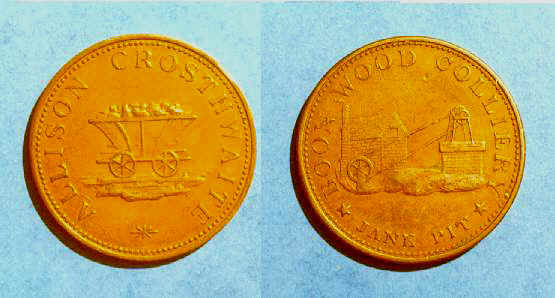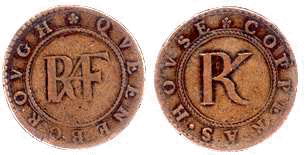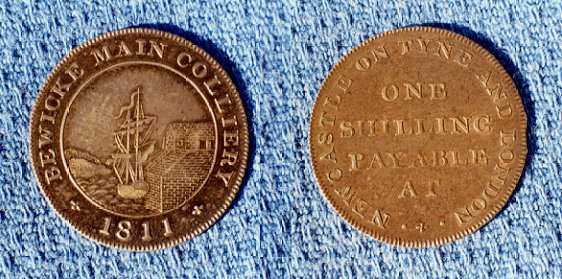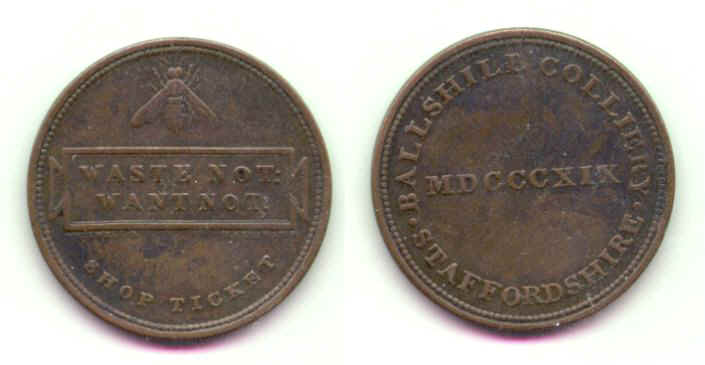
Mining Memorabilia - Paranumismatics (Part I)
Some of the earliest forms of commonly collected mining tokens are categorized and briefly described below;
Carriers’ Tokens – One of the first recorded uses of tokens in the British mining industry occurs in the West Cumberland Coalfield as early as the 1670s.

Obverse & reverse of a coal carrier’s token from West Cumberland. Obverse design depicts the family crest (a dragon) of the collier owning Lowther family who issued the token c.1690. Reverse bears the legend "LOWTHER" in cypher fashion. (Actual size 22.5mm Ć)
Many of the issues of the extensive West Cumberland token series were used as tallies serving one or more of the following purposes;
Issued to colliers as token payment for winning and/or raising a set quantity of coal.
Issued to coal carriers (i.e. pack horse leaders) as a receipt in recognition of a fixed quantity of coal transported from the pitheads to one of the local ports or inland markets.
Issued by colliery agents or coal carriers to landowners as a form of wayleave or toll payment tally in recognition of a fixed quantity of coal transported over private land.
These early tokens were used extensively by the coal owners’ agents in settling up haulage payments in addition to providing a useful means of keeping a check on coal production and shipment tonnages.
The use of carriers' tokens continued in Cumberland well into the nineteenth century. A similar but not quite as extensive series of eighteenth and nineteenth century tokens are also known from areas of the Scottish coalfields plus a few other UK mining districts. One such additional example is that issued by Hugh Boyd in the 1730s/40s for use in his collieries and salt pans at Ballycastle in the County Antrim, Northern Ireland.

A carriers or possibly a truck token issued by the coal master Allison Crosthwaite during the period 1781 to 1831. The token's obverse depicts a full coal wagon or "chaldron". Its reverse shows the head frame and steam winder serving the Jane Pit of Boon Wood Colliery at Distington (not to be confused with the nearby Jane Pit at Workington) in West Cumberland (Actual size 31mm Ć).
Copperas Tokens - Another early and rather enigmatic series of tokens relating to the British minerals industry emanate from the copperas producers of south east England.
For many centuries up until the mid 1800s iron pyrite nodules (or copperas stones) were gathered on several beaches along the east Kent and Essex coasts. The copperas stones where encapsulated in the London clays which made up the shore lines and were exposed and washed onto the beaches in great quantity after storms.
Copperas stone gathering was a common occupation for many of the local paupers and their children. One observer writing in the early 1600s noted that it was not uncommon in the space of a single tide for the men or women gatherers to collect between 10 and 12 bushels (1 bushel = 8 gallons) of copperas stone while the children could normally manage 4 bushels. The collected stones were normally gathered into heaps on the shore where they remained until they were eventually loaded onto flat bottomed barges, or hoys, which were used to transport them the short distance along the coast to one of the local Copperas Houses. Here the stones underwent the long water based leaching process which ultimately resulted in the production of green vitriol or copperas (.i.e. hydrated iron sulphate). Copperas was the principle raw material used in the production of many early black dyes and inks. In addition it was also used in the manufacture of brimstone (.i.e. sulphur) and oil of vitriol (.i.e. sulphuric acid).

Obverse & reverse of one of the Queenborough Copperas House tokens. The monogrammed initials "RAF" & "RK" are believed to be those of Ralph Farr & Roger Kemp who were granted the lease to collect copperas stones on the beaches around Minster between 1676 and 1706. The token undoubtedly dates from that period. (Actual size 25mm Ć)
Although very little is known for sure about copperas tokens it is widely believed that they were used as a form of token payment given out to stone gatherers or hoy men in recognition of either a certain quantity of stone collected or delivered to the local Copperas House for processing. The tokens were presumably redeemable at their respective issuing Copperas House for coin of the realm.
Most of the known copperas tokens are believed to date from the late 1600s to mid 1700s. However the high degree of wear commonly found on certain types (e.g. those bearing the place name WALTON and the initials JK in their legends plus a counter stamped date of 1736) indicates that they probably continued to be used for many decades after their initial issue.
Only seven different types of copperas tokens are known. These originate from the ancient Copperas Houses at the following locations;
Queenborough on the Isle of Sheppey, Kent
Minster on the Isle of Sheppey, Kent
Walton-on-the-Naze, Essex
Frinton-on-Sea, Essex
Commercial Tokens - The earliest mining related tokens known from the British Isles are those circulated by a handful of colliery owners and coal carriers operating in the mid seventeenth century. Such tokens are recorded from various locations within the traditional coalfield areas of Yorkshire, Lancashire, Warwickshire, Shropshire, Cumberland, and Derbyshire. One of the most famous of this series of tokens is that issued by the Shallcross family on behalf of their small coal pits near Buxton in Derbyshire.
Such tokens formed part of a plethora of privately minted halfpennies and farthings most of which date from the 1640’s to 1660's. They were commissioned by tradesmen, innkeepers and some local authorities in response to a shortage in the circulating levels of officially minted small change. Mining related issues only represent a very tiny fraction of the tokens produced during this first great epoch in the history of Britain’s token coinage.
It wasn’t until much later during the period 1787 to 1819 that Britain was again to resort to the wide scale use of a commercial token coinage. The two short intervals from 1787 to 1797 and 1811 to 1819 in particular were to represent the most prolific issuing period for tokens in British history.
As had been the case in the mid seventeenth century it was private traders and industrialists who brought about the revival in the use of token coinage in Britain during the late 1780s. The reasons for resorting to a token coinage was again due to a dearth in the circulating levels of regal copper coinage. For various reasons the British government of the time was reluctant to enter into new and consistent coining contracts with the Royal Mint. However, unlike the earlier token series of the seventeenth century, of which only a very small percentage were mining related, those re-introduced in the late eighteenth and early nineteenth centuries were directly initiated by Britain’s mining industry whose token issues are highly represented in the overall series. Such had become the importance of the metals and coal trade to Britain during its celebrated period of industrial revolution.
The huge series of tokens eminating from Britain’s industrial and commercial sectors after the late 1780’s were not officially recognized as legal tender by the British government. However, they never the less circulated in parallel with the country’s regal currency.
The Parys Mine Company under the leadership of Thomas Williams, the legendary "Copper King" of industrial folklore, had the honor of being the organization to re-introduce the use of private commercial tokens in Britain in 1787. The company’s first issues were of penny tokens and were primarily intended as a form of payment to the employees engaged in its mines and smelters in Wales. The Parys Mine tokens were of good weight (one ounce) and size containing copper of an equivalent intrinsic worth to their face value. The metal used in the manufacture of these tokens was from the company’s own mine on the island of Anglesey. The metal was smelted and initially coined in the company’s own private mint located at Holywell in North Wales. Production of the tokens was later moved to Birmingham.

Reverse of an Associated Irish Mine Company Halfpenny token of 1789 (Actual size 29.5mm Ć).
The quantity in which the Parys Mine Company tokens were made and circulated attest well to their general acceptance within Britain’s commercial and industrial sectors. Over the full period of their minting over 250 tons of pennies and 50 tons of halfpennies were struck in the name of the Parys Mine Company.

A silver shilling issued by the Bewicke Main Coal Company in 1811. Obverse depicts a collier vessel moored along staiths on the River Tyne. The reverse states that the token is payable (.i.e. exchangeable for coin of the realm) at Newcastle & London (Actual size 25mm).
Other commercial and industrial ventures were quick to follow the lead of the Parys Mine Company and so started a flood of token issues that circulated widely throughout Britain and Ireland. Amongst some of the other mining companies that entered into this frenzy of token issuing were the following;
Cornish Metal Company (Cornwall)
The Priestfield Collieries & Furnaces of Samuel Fereday (Bilston, Staffordshire)
Bewicke Main Colliery (County Durham)
Percy Main Colliery (Northumberland)
The Associated Irish Mine Company (Cronebane, Ireland)
Gwennap Copper & Tin Mines (Scorrier, Cornwall)
Dolcoath Copper & Tin Mine (Dolcoath, Cornwall)
West Wheal Fortune Mine (Ludgvan, Cornwall)
The Rose Copper Company (Redruth, Cornwall)
The Birmingham Mining & Copper Company (Redruth, Cornwall)
Devon Mines (Tavistock, Devon)
Hibernian Mine Company (Ballymurtagh, Ireland)
Castlecomer Colliery (County Kilkenny, Ireland)
Alloa Colliery (Clackmannanshire, Scotland)
The Macclesfield Copper Company
The Ironstone, coal and lead mines of Iron Master John Wilkinson (Shropshire & North Wales)
Truck Tokens - Prior to 1831 it had been common in some areas of the UK for the mine owners to pay their employees in company issued "Truck" (i.e. tokens).
The "Truck System" was that whereby workers’ wages were paid in tokens (commonly called scrip in the US coal mining industry where their use continued in some area into the 1950s) that were only exchangeable in the company’s own store.
Such employee payment systems became very popular amongst many of the UK's industrial concerns in the early nineteenth century. Initially the company owned stores or "Tommy Shops" met a real need for many mining communities as there were often no other shops in the vicinity of the newly sunk pits at which the miners could buy essential supplies. However, during the 1820’s many of the mine owners saw their company stores as yet another means of earning them more profit by selling poor quality goods at excessive prices. What is more the Truck System encouraged many miners to buy goods on credit for prices substantially higher than their normal cash value. This often lead to the miners getting into increasing debt with their company store thereby tying them more strongly to their unscrupulous employers.

A truck token issued by the owners of Balls Hill Colliery, West Bromwich in 1819. The legend in the token's obverse centre field reads "WASTE NOT WANT NOT". (Actual size 32mm Ć).
The Truck system was made illegal under an Act of Parliament dated 1831. However, this legislation was not totally effective. In some areas of the UK, such as the South Wales coal and iron ore fields, several ironmasters and coal owners continued to use truck tokens intermittently until the passing of the Truck Amendment Act of 1887. This was despite the fact that in 1830 it had been protests against the Truck system that had sparked off the infamous Merthyr Tydfil riots. These bloody riots lasted for several days and claimed the lives of many welsh miners not to mention those of several of soldiers dispatched to quell them.